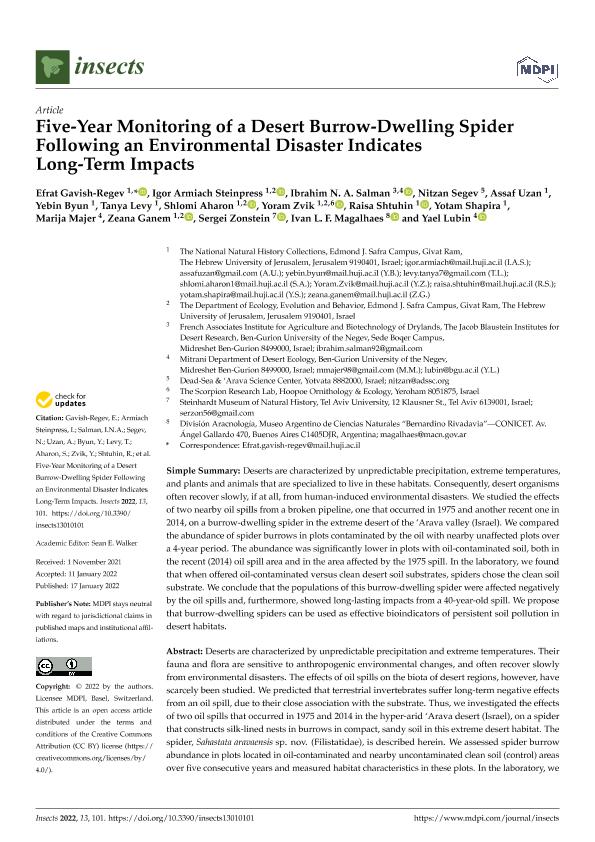Mostrar el registro sencillo del ítem
dc.contributor.author
Gavish Regev, Efrat
dc.contributor.author
Armiach Steinpress, Igor
dc.contributor.author
Salman, Ibrahim N. A.
dc.contributor.author
Segev, Nitzan
dc.contributor.author
Uzan, Assaf
dc.contributor.author
Byun, Yebin
dc.contributor.author
Levy, Tanya
dc.contributor.author
Aharon, Shlomi
dc.contributor.author
Zvik, Yoram
dc.contributor.author
Shtuhin, Raisa
dc.contributor.author
Shapira, Yotam
dc.contributor.author
Majer, Marija
dc.contributor.author
Ganem, Zeana
dc.contributor.author
Zonstein, Sergei
dc.contributor.author
Fiorini de Magalhaes, Ivan Luiz

dc.contributor.author
Lubin, Yael
dc.date.available
2023-10-27T11:43:53Z
dc.date.issued
2022-01
dc.identifier.citation
Gavish Regev, Efrat; Armiach Steinpress, Igor; Salman, Ibrahim N. A.; Segev, Nitzan; Uzan, Assaf; et al.; Five-Year Monitoring of a Desert Burrow-Dwelling Spider Following an Environmental Disaster Indicates Long-Term Impacts; MDPI; Insects; 13; 1; 1-2022; 1-26
dc.identifier.issn
2075-4450
dc.identifier.uri
http://hdl.handle.net/11336/216145
dc.description.abstract
Deserts are characterized by unpredictable precipitation and extreme temperatures. Their fauna and flora are sensitive to anthropogenic environmental changes, and often recover slowly from environmental disasters. The effects of oil spills on the biota of desert regions, however, have scarcely been studied. We predicted that terrestrial invertebrates suffer long-term negative effects from an oil spill, due to their close association with the substrate. Thus, we investigated the effects of two oil spills that occurred in 1975 and 2014 in the hyper-arid ‘Arava desert (Israel), on a spider that constructs silk-lined nests in burrows in compact, sandy soil in this extreme desert habitat. The spider, Sahastata aravaensis sp. nov. (Filistatidae), is described herein. We assessed spider burrow abundance in plots located in oil-contaminated and nearby uncontaminated clean soil (control) areas over five consecutive years and measured habitat characteristics in these plots. In the laboratory, we determined the preference of individuals for clean vs. oil-contaminated soil as a resting substrate. Finally, as this species was previously undescribed, we added a new species description. The abundance of Sahastata was significantly lower in oil-contaminated plots, and this was the case in the 40-year-old oil spill (1975) as well as in the recent one (2014). In laboratory tests, spiders showed a significant preference for the clean soil substrate over the oil-contaminated substrate. In the field, soil crust hardness and vegetation density did not differ significantly between oil-contaminated and control plots, but these measures were highly variable. The burrows were significantly clustered, suggesting that the young disperse only short distances. In the laboratory adult spiders did not dig burrows, perhaps indicating that adults remain permanently in their natal burrows and that in the field they may use vacant burrows. We conclude that Sahastata populations were affected negatively by the oil spills and these effects were long-lasting. We propose that by monitoring their spatial distribution, burrow-dwelling spiders such as Sahastata can be used as effective bioindicators of soil pollution in desert habitats.
dc.format
application/pdf
dc.language.iso
eng
dc.publisher
MDPI
dc.rights
info:eu-repo/semantics/openAccess
dc.rights.uri
https://creativecommons.org/licenses/by/2.5/ar/
dc.subject
ARANEAE
dc.subject
BIOINDICATOR
dc.subject
FILISTATIDAE
dc.subject
HYPER-ARID
dc.subject
OIL-SPILL
dc.subject
SAHASTATA
dc.subject
ARAVA VALLEY
dc.subject
AVRONA
dc.subject.classification
Ecología

dc.subject.classification
Ciencias Biológicas

dc.subject.classification
CIENCIAS NATURALES Y EXACTAS

dc.title
Five-Year Monitoring of a Desert Burrow-Dwelling Spider Following an Environmental Disaster Indicates Long-Term Impacts
dc.type
info:eu-repo/semantics/article
dc.type
info:ar-repo/semantics/artículo
dc.type
info:eu-repo/semantics/publishedVersion
dc.date.updated
2023-10-26T15:22:00Z
dc.journal.volume
13
dc.journal.number
1
dc.journal.pagination
1-26
dc.journal.pais
Suiza

dc.description.fil
Fil: Gavish Regev, Efrat. The Hebrew University of Jerusalem; Israel
dc.description.fil
Fil: Armiach Steinpress, Igor. The Hebrew University of Jerusalem; Israel
dc.description.fil
Fil: Salman, Ibrahim N. A.. No especifíca;
dc.description.fil
Fil: Segev, Nitzan. The Hebrew University of Jerusalem; Israel
dc.description.fil
Fil: Uzan, Assaf. The Hebrew University of Jerusalem; Israel
dc.description.fil
Fil: Byun, Yebin. The Hebrew University of Jerusalem; Israel
dc.description.fil
Fil: Levy, Tanya. The Hebrew University of Jerusalem; Israel
dc.description.fil
Fil: Aharon, Shlomi. The Hebrew University of Jerusalem; Israel
dc.description.fil
Fil: Zvik, Yoram. The Hebrew University of Jerusalem; Israel
dc.description.fil
Fil: Shtuhin, Raisa. The Hebrew University of Jerusalem; Israel
dc.description.fil
Fil: Shapira, Yotam. The Hebrew University of Jerusalem; Israel
dc.description.fil
Fil: Majer, Marija. The Hebrew University of Jerusalem; Israel
dc.description.fil
Fil: Ganem, Zeana. The Hebrew University of Jerusalem; Israel
dc.description.fil
Fil: Zonstein, Sergei. Steinhardt Museum Of Natural History, Tel-aviv Universi; Israel
dc.description.fil
Fil: Fiorini de Magalhaes, Ivan Luiz. Consejo Nacional de Investigaciones Científicas y Técnicas. Oficina de Coordinación Administrativa Parque Centenario. Museo Argentino de Ciencias Naturales "Bernardino Rivadavia"; Argentina
dc.description.fil
Fil: Lubin, Yael. No especifíca;
dc.journal.title
Insects
dc.relation.alternativeid
info:eu-repo/semantics/altIdentifier/url/https://www.mdpi.com/2075-4450/13/1/101
dc.relation.alternativeid
info:eu-repo/semantics/altIdentifier/doi/http://dx.doi.org/10.3390/insects13010101
Archivos asociados
